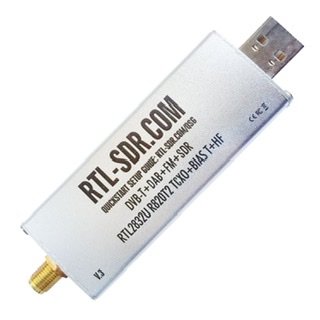
I must have been sleeping when the announcement of the favorite gadget contest was announced and was oblivious when all of the posts appeared. So now that it’s over, I can share one of mine with no pressure :).
A software defined radio (SDR) is basically an analog to digital converter that coverts an analog radio frequency (RF) signal to a real-time digital data stream. The device shown here is receive-only but there are many others on the market that can also generate an RF signal to be fed to an amplifier. In the picture, you can see the antenna connection on the lower left and a USB port in the upper right. This device is just a bit bigger than a thumb drive but can handle frequencies of 30 MHz to 1300 MHz! The data is fed through the USB to a software application (very good open source versions are available) which controls the frequency being converted and other parameters, plays the audio, and displays a plot of the signals being received. Of course, you also need an antenna for the general RF band you are interested in to get the best reception.
I got mine when I was studying for my amateur radio (HAM) license so that I could get familiar with the radio spectrums I would be authorized to use and to hear what the chatter sounded like (and because SDRs are really cool toys and I finally had an excuse to try it out!). Like anything new and unfamiliar, it took a little time to get the software set up and to figure out what it was showing me, but it wasn’t a difficult process (the place to start is at the URL right on the device in the picture!). I happened to use a PC, but there is code for almost any platform ready to install (and more if you compile it yourself).
The code acts as a digital signal processor (DSP) and performs fast Fourier transforms (FFT) and other magic. Quoting Wikipedia:
The Fourier transform (FT) decomposes a function of time (a signal) into its constituent frequencies. This is similar to the way a musical chord can be expressed in terms of the volumes and frequencies of its constituent notes. The term Fourier transform refers to both the frequency domain representation and the mathematical operation that associates the frequency domain representation to a function of time. The Fourier transform of a function of time is itself a complex-valued function of frequency, whose magnitude (modulus) represents the amount of that frequency present in the original function, and whose argument is the phase offset of the basic sinusoid in that frequency.
Like I said - magic :). Luckily all you need to do is follow the many well-written discussions on setting up and using the software found on the web. Once set up, your computer becomes as capable as most ham radios you can find on the market (well, receive only, within it’s frequency range and with the right antenna - but even an inexpensive one will do amazing things). So now you know that if you have any interest at all in the topic, you can dip your toes in without get all wet...
BTW - I did get my ham license. My call sign is KE0RQE. But don’t try to reach me on the radio. I seem to find myself here on Steem more than I care to admit!
Congratulations @jdkennedy! You have completed the following achievement on the Steem blockchain and have been rewarded with new badge(s) :
You can view your badges on your Steem Board and compare to others on the Steem Ranking
If you no longer want to receive notifications, reply to this comment with the word
STOPVote for @Steemitboard as a witness to get one more award and increased upvotes!
Downvoting a post can decrease pending rewards and make it less visible. Common reasons:
Submit
I loved reading about you playing with your favorite toy. Utterly clueless what on earth you can actually "do" with this stick but I am going to look into this because new language and technology always excites me. I have found a fellow Steemian who has become my private tutor, amontst other things, so we have our homework cut out for me this weekend!
Downvoting a post can decrease pending rewards and make it less visible. Common reasons:
Submit